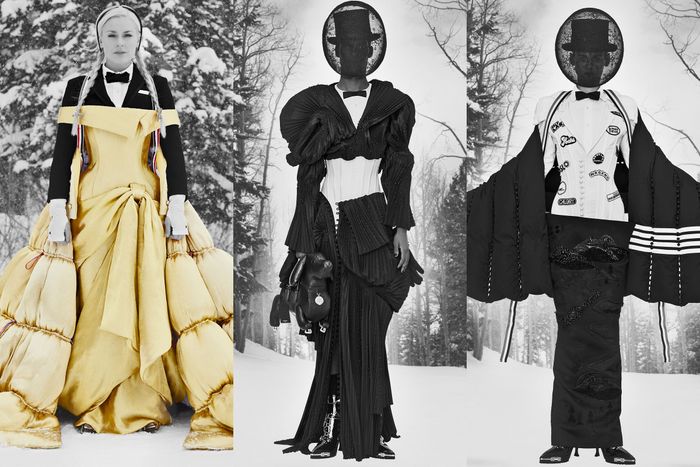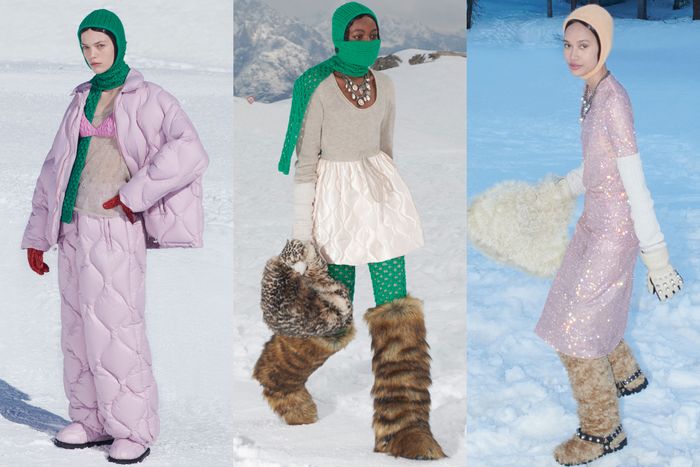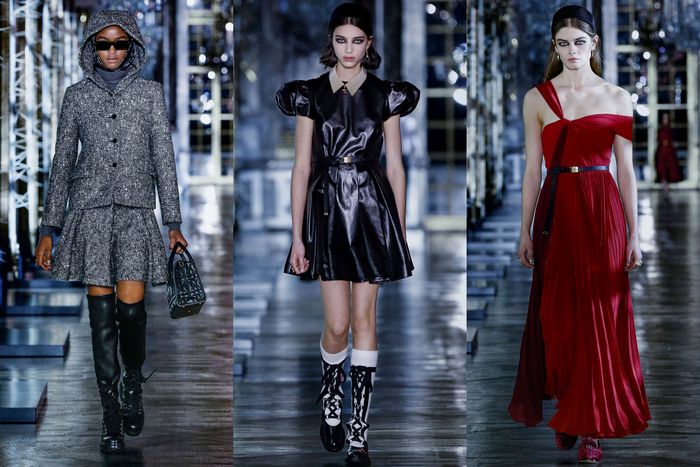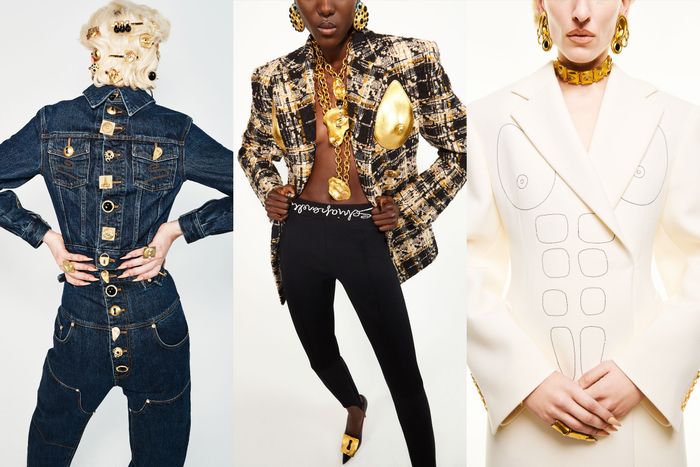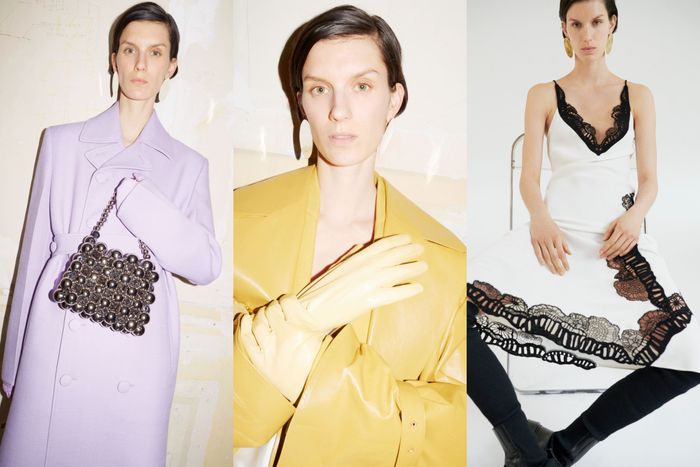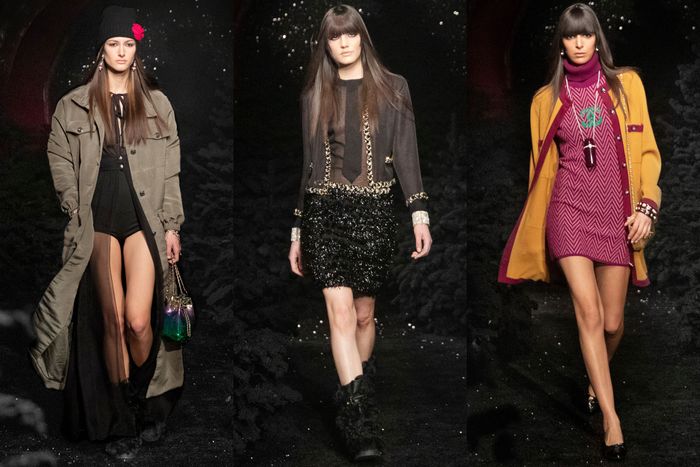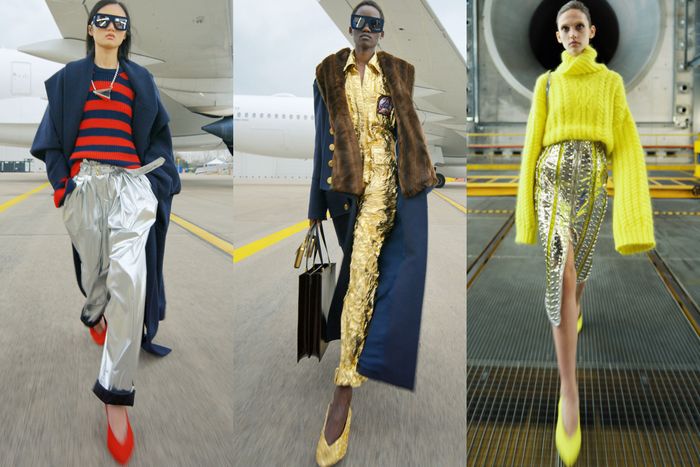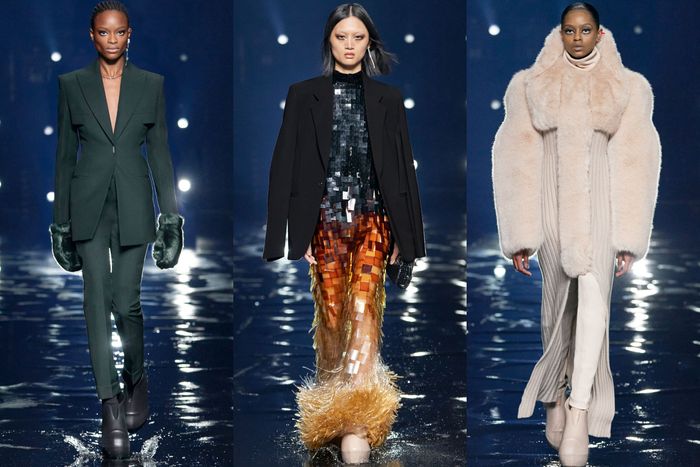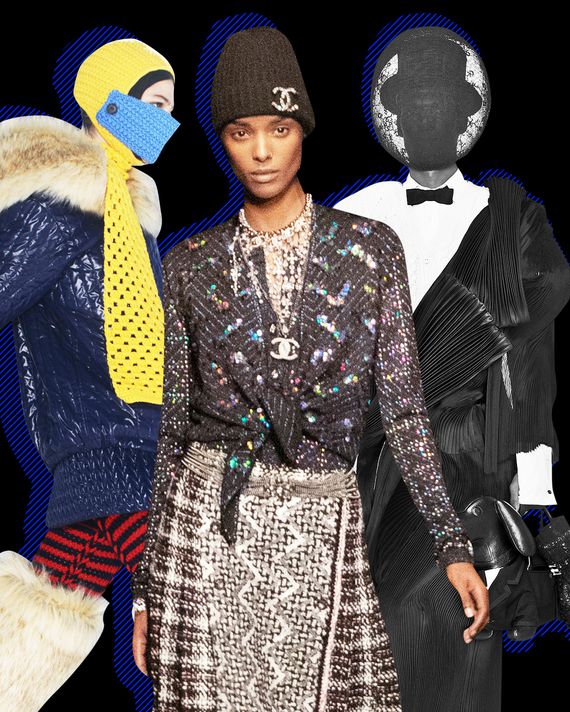
.
The Storytellers: Thom Browne, Miu Miu, and Christian Dior
The strange paradox of the pandemic is that closing things down made designers aim higher. How high? Miuccia Prada went to the Dolomites, in northeastern Italy, to film her Miu Miu pastel ski suits and yeti-fur boots. She reasoned, “If I don’t do the snow this time, I probably will never be able to do it.” For his film, Thom Browne chose a black-diamond run on Utah’s Solitude Mountain, in part because it was close to the home of his star, Lindsey Vonn. “I thought, Well, if I’m going to do this, I want to do it with Lindsey jumping out of a helicopter and skiing in a tuxedo,” he said.
Maria Grazia Chiuri only traveled a few miles from the center of Paris for her Dior show based on fairy tales. Still, as over-the-top settings go, Versailles is hard to beat.
Of the three, Browne’s film was far and away the most satisfying, for the reason that it told a story that incorporated not only the mountains and Vonn, who turns out to be a good actress, but also the clothes. In a sense, every outfit was a mini-story, relating to winter sports — the contouring micro-pleats on jackets that evoked an aerial view of skiers doing turns down a slope, the patches on a skirt or snow-white corset that recalled the sites of Winter Olympics, the black mesh halos on the models’ heads that suggested helmets. The pattern for the last skirt in the presentation, a billowy thing, was based, Browne said, on a figure skater’s routine at the 1960 games.
At the same time, there were connections to cinema of the 1930s — in the black-and-white clothes, in the searching close-ups of Vonn’s face. As Browne said, “We’ve had to get so modern in the way that we approach everything this year, I thought it would be interesting to go old-school and do everything in black-and-white.” But the black-and-white clothes served another purpose, I thought. He lamented that some of the details get lost in film, and it’s true. You can’t really appreciate the jet beading on a black tunic, which Browne paired with a dramatic white shirt and a pleated skirt, or the meticulous fit of everything. He said, “Nothing will replace seeing things in person, and I can’t wait to get back to that.” But, thanks to the snow and the perspective of the cameras, you can see the amazing line and form of the clothes. And that wouldn’t be possible, or anyway as effective, even in the larger Paris venues where the designer usually shows.
Browne is a great storyteller with a funny bone, so it’s not surprising that he seized this strange moment to expand his method with video. Prada, during a Zoom conference call on Tuesday, acknowledged the difficulty of the medium. “Basically, it’s a new job for us,” she said. “I am a fashion designer and not a director.”
In a way, the soaring Dolomites subbed as the story at Miu Miu. The company tried to spin a girl-gang theme, of “kinships” and “bravery in endeavor,” that sort of thing. But the girls were ultimately models on parade at high altitude. (And when has a Miu Miu show not suggested a girl gang, even in the posh settings where Prada typically shows?) The truth is the oversized quilted snowsuits and knitted balaclavas will look fab and silly anywhere next winter, from Brooklyn to Val d’Isère. Ditto the slip dresses layered up with knits. But the opportunity to tell a story, and not merely relate some clothes to an environment, was missed.
Chiuri showed her storytelling abilities in January, with a brilliant haute-couture collection that in shape, color, and artistry conveyed Dior’s links to European culture. It’s probably the best work she’s done, and it’s also a high-water mark in the history of the house. With ready-to-wear, Chiuri tends to take a more commercial position — summed up this season with a suit in salt-and-pepper tweed with a boxy hooded jacket and a flared skirt, new-looking babydoll dresses in black leather or white eyelet, and the floaty princess dresses that she likes. I guess the hooded pieces were a nod to a famous fairy tale, the tulle frocks to another?
Again, despite the August setting and some scenes shot in a misty wood, the presentation turned into a runway parade. What I really wish is that Chiuri wouldn’t let Dior ready-to-wear be such a creative laggard to couture.
.
The Breakout Stars: Jil Sander and Schiaparelli
Daniel Roseberry, the Schiaparelli creative director who designed Lady Gaga’s Inaugural look, said recently that he didn’t want Schiaparelli ready-to-wear to be different from haute couture — that is, “just another luxury-machine collection.” Clearly, Roseberry was prepared to back up that statement. His latest collection has everything that gets under your skin and which you can’t explain without sounding like a nerd — line, form, subversive wit, and a total mastery of fit and construction.
In the hands of another designer, a blue-denim jumpsuit with the front pockets and stitching reversed to the back and gold buttons clamoring up the spine might look cheesy, but Roseberry keeps things elevated. The anatomical references — to ears, eyes, breasts — on the gold buttons and in 3-D embroidery may raise a hackle or two, but they’re solidly in the Surrealist tradition of Schiaparelli. And, again, Roseberry handles them well. He probably called upon Cocteau to draw the spare black lines, representing breasts and vertebrae, on the front of a clean white wool coat. What I loved most, though, about this dazzling collection was that it showed how a strong line can govern everything — as in, a perfectly cut black coat with single lock closure in gold at the waist.
Lucie and Luke Meier’s Jil Sander has been eminently reachable — and in a way, that’s the problem. They were doing minimalism without mystery, without an undertow. Maybe they needed a crisis to clear their heads. Whatever the cause, Jil Sander was among the most arresting collections of the season. The Meiers scaled down volumes (a good thing, since many designers pumped them up); they used fresh colors like lavender, rose, and Tuscan yellow (for a trim leather coat); and they used prints and details like a scalloped collar to provide a nice bit of tension to the tailoring. Not only did an ivory slip dress — embellished with a rigid hem of black lace and worn with a black blazer — address the body in a tough, new way (for the Meiers), it appealed to women looking for something manifestly strong and modern. Jil Sander is again redefining minimalism.
.
Getting Intimate: Chanel, Balmain, and Givenchy
Virginie Viard answered everyone’s prayers: She brought Chanel out of a big public space and into a warm, human space — namely, Castel’s nightclub in Paris. Her film, shot by Inez & Vinoodh, showed the iron-haired models streaming down the club’s narrow stairs and tossing their coats on a counter, to reveal wispier underthings. The film did far more than a live show to convey Viard’s kind of relaxed French glamour. Personally, I find her a top-heavy designer; her bottoms never seem resolved. Still, she’s mindful about a wardrobe, and there are many good bits here, like a rangy olive-drab coat, classic blue shirts with white collars, furry ski boots, and vessels on chains for holding your lipstick and such.
“For me, digital is just a tool, and I don’t like it,” Olivier Rousteing said before his Balmain presentation. “I mean, I don’t like doing something just for a screen.” Be that as it may, Rousteing did a brilliant, funny job with this collection, shot at an Air France hangar. What could be more ditzily French than models walking on the wing of a grounded plane? Or wearing a striped nautical top, but with a gorgeous, sweeping overcoat and a pair of wide-leg metallic pants? What I loved about this collection was how loose and open the expression was, from olive “parachute” dresses, to the silver- and gold-laminated leather, to minidresses made of a quilted jangle of leather, after an aircraft’s electrical system. It was not only a different view of La Parisienne, but a different Balmain.
Without a doubt, Matthew Williams has settled down a bit at Givenchy since his debut last year. His tailoring looked more intentional and less overthought, and it was clear that he was exploring scale — with almost dense-looking puffers, generous coats, and blocky shoes, made from a foam, that seemed a next generation of Alexander McQueen’s famous Armadillo booties. But the collection didn’t give off much feeling. It could be because the models were accessorized to the hilt, and because many of the clothes lacked a suppleness, a roundness that you get at the highest level of fashion. Williams’s predecessors had it. It saves ready-to-wear from looking stamped out. Perhaps in time, Williams will discover it for himself.



